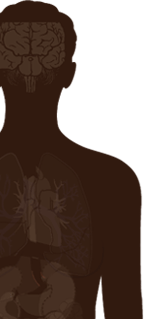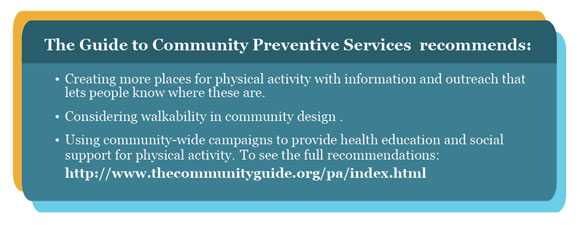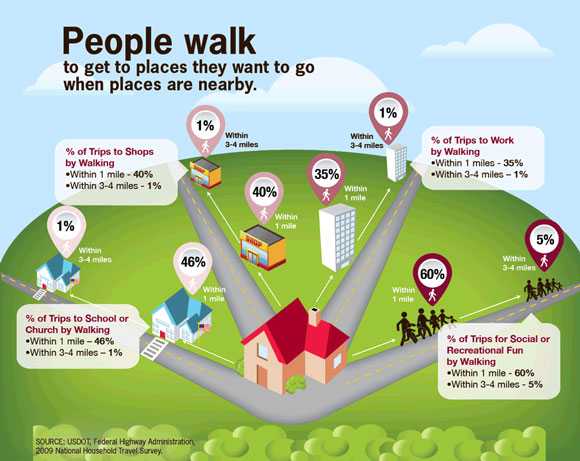More People Walk to Better Health
On This Page
August 2012


 48%
48%
About half of all adults get enough aerobic physical activity* to improve their health.
 6 in 10
6 in 10
Walking is the most popular aerobic physical activity. About 6 in 10 adults reported walking for at least 10 minutes in the previous week.
 6%
6%
Adults who walk for transportation, fun, or exercise went up 6 percent in 5 years.
More than 145 million adults now include walking as part of a physically active lifestyle. More than 6 in 10 people walk for transportation or for fun, relaxation, or exercise, or for activities such as walking the dog. The percentage of people who report walking at least once for 10 minutes or more in the previous week rose from 56% (2005) to 62% (2010).
Physical activity helps control weight, but it has other benefits. Physical activity such as walking can help improve health even without weight loss. People who are physically active live longer and have a lower risk for heart disease, stroke, type 2 diabetes, depression, and some cancers. Improving spaces and having safe places to walk can help more people become physically active.
*Aerobic activities like brisk walking, running, swimming and bicycling make you breathe harder and make your heart and blood vessels healthier.
Problem
Americans need more physical activity
Less than half of all adults get the recommended amount of physical activity.
- Adults need at least 2 and 1/2 hours (150 minutes) a week of aerobic physical activity. This should be at a moderate level, such as a fast-paced walk for no less than 10 minutes at a time.
- Women and older adults are not as likely to get the recommended level of weekly physical activity.
- Inactive adults have higher risk for early death, heart disease, stroke, type 2 diabetes, depression, and some cancers.
- Regular physical activity helps people get and keep a healthy weight.
- Walkable communities result in more physical activity.
More people are walking, but just how many depends on where they live, their health, and their age.
- The West and Northeast regions have the highest percentage of adults who walk in the country, but the South showed the largest percent increase of adults who walk compared to the other regions.
- More adults with arthritis or high blood pressure are now walking, but not those with type 2 diabetes.
- Walking increased among adults 65 or older, but less than in other age groups.
People need safe, convenient places to walk.
- People are more likely to walk and move about more when they feel protected from traffic and safe from crime and hazards.
- Maintaining surfaces can keep people who walk from falling and getting hurt. This also helps wheelchairs and strollers and is safer for people with poor vision.
- People need to know where places to walk in their communities exist that are safe and convenient.
- Walking routes in and near neighborhoods encourage people to walk to stops for buses, trains, and trolleys.



What Can Be Done
US government is
- Working with partners to carry out the National Prevention Strategy to make physical activity easier where people live, work, and play.
- Helping people get active through programs like Community Transformation Grants and Nutrition, Physical Activity, and Obesity state programs, and by working with partners like Safe Routes to Schools.
- Studying ways that communities can make it easy and convenient for people to be more active.
State or local governments can
- Consider walking when creating long-range community plans.
- Consider designing local streets and roadways that are safe for people who walk and other road users.
- Consider opportunities to let community residents use local school tracks or gyms after classes have finished.
- Make sure existing sidewalks and walking paths are kept in good condition, well lit and free of problems such as snow, rocks, trash, and fallen tree limbs.
- Promote walking paths with signs that are easy to read, and route maps that the public can easily find and use.
Employers can
- Create and support walking programs for employees.
- Identify walking paths around or near the work place and promote them with signs and route maps.
- Provide places at work to shower or change clothes, when possible.
Individuals can
- Start a walking group with friends and neighbors.
- Help others walk more safely by driving the speed limit and yielding to people who walk.
- Use crosswalks and crossing signals when crossing streets and not jaywalk.
- Participate in local planning efforts that identify best sites for walking paths and sidewalks.
- Work with parents and schools to encourage children to walk to school where safe.
Science Behind the Issue
Related Pages
- Vital Signs: Walking Among Adults — United States, 2005 and 2010. Morbidity and Mortality Weekly Report (MMWR)
- CDC Feature – 6 in 10 Adults Now Get Physical Activity by Walking
- More Adults Are Walking [PODCAST – 1:15 minutes]
- More Adults Are Walking – What You Need to Know [PSA – 0:60 seconds]
- Winnable Battles
On Other Web Sites
- Page last reviewed: August 6, 2013
- Page last updated: August 6, 2013
- Content source:
Error processing SSI file


 ShareCompartir
ShareCompartir